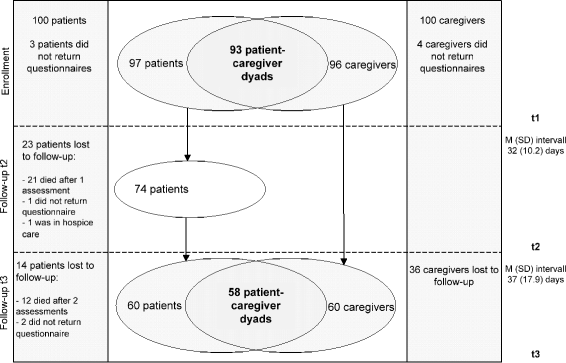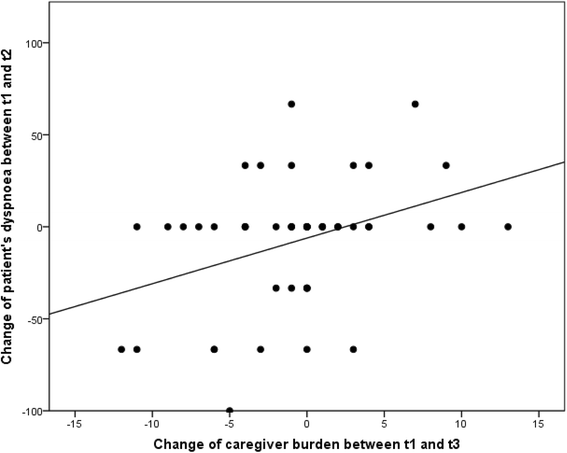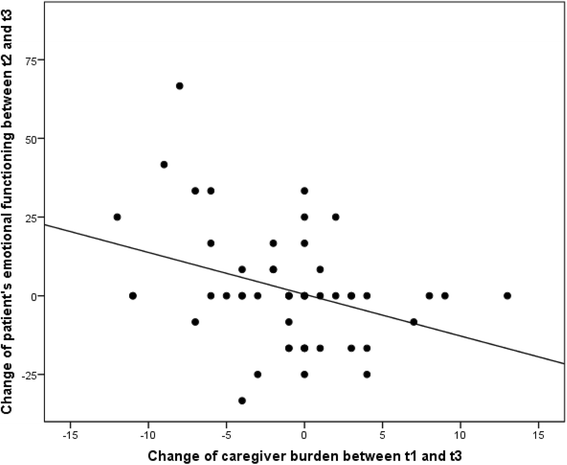Correlation between patient quality of life in palliative care and burden of their family caregivers: a prospective observational cohort study
- PMID: 26767785
- PMCID: PMC4714452
- DOI: 10.1186/s12904-016-0082-y
Correlation between patient quality of life in palliative care and burden of their family caregivers: a prospective observational cohort study
Abstract
Background: Family caregivers play a key role in palliative care at home, and understanding the interdependencies in the constellation of patient, family caregivers and service providers is important. As few longitudinal studies have examined the influence of patient quality of life (QoL) in palliative care on burden of family caregivers, the aim of this study was to identify correlations between changing patient QoL and changing burden of family caregivers that need consideration in patient management.
Methods: Palliative patients with cancer in primary care evaluated their QoL (Quality of Life Questionnaire Core 15 Palliative Care, QLQ-C15-PAL). They were assessed monthly for an interval of 6 months or until death of the patient. Family caregivers reported the burden they perceived while supporting the patient (Short form of the Burden Scale for Family Caregivers, BSFC). Longitudinal data were analysed for all patients with at least 3 available assessments, considering the most recent data for participants with more than 3 assessments. Changes in patient QoL were analysed using the Friedman test. In a stepwise regression analysis, influences of change in patient QoL on changing caregiver burden were investigated.
Results: One hundred patients (63 men, 37 women; average age: 68 years) were enrolled in the study. The most common primary diagnoses were colon, lung or breast cancer. In 58 cases, assessments were available from both patients and caregivers. Patients reported overall quality of life increasing towards end of life, although reporting that physical functioning deteriorated. Symptoms of pain and fatigue bothered patients most. Caregiver burden was moderate and on average did not change over time. In a stepwise regression model, the difference in emotional functioning and the difference in dyspnoea showed an influence on the development of caregiver burden (explained variance of 19.3%).
Conclusions: Patients' dyspnoea, feelings of depression and anxiety impacted on the perceived burden of family caregivers, but are manageable symptoms. Our results corroborate the need of regular assessment of patients' needs taking into account caregiver burden. In this way, general practice teams can intervene early and may more likely meet patients' needs in the end of life care process.
Trial registration: Current Controlled Trials ISRCTN78021852, assigned on 04/04/2007.
Figures



Similar articles
-
Association between family satisfaction and caregiver burden in cancer patients receiving outreach palliative care at home.Palliat Support Care. 2018 Jun;16(3):260-268. doi: 10.1017/S1478951517000232. Epub 2017 May 2. Palliat Support Care. 2018. PMID: 28462749
-
Effect of Inpatient Palliative Care on Quality of Life 2 Weeks After Hematopoietic Stem Cell Transplantation: A Randomized Clinical Trial.JAMA. 2016 Nov 22;316(20):2094-2103. doi: 10.1001/jama.2016.16786. JAMA. 2016. PMID: 27893130 Free PMC article. Clinical Trial.
-
Effectiveness of a specialized outpatient palliative care service as experienced by patients and caregivers.J Palliat Med. 2013 Aug;16(8):848-56. doi: 10.1089/jpm.2012.0491. Epub 2013 May 16. J Palliat Med. 2013. PMID: 23678854
-
The benefits of early palliative care on psychological well-being, functional status, and health-related quality of life among cancer patients and their caregivers: a systematic review and meta-analysis.BMC Palliat Care. 2025 Apr 28;24(1):120. doi: 10.1186/s12904-025-01737-y. BMC Palliat Care. 2025. PMID: 40296046 Free PMC article.
-
[Caregiver burden in relatives of persons with schizophrenia: an overview of measure instruments].Encephale. 2003 Mar-Apr;29(2):137-47. Encephale. 2003. PMID: 14567165 Review. French.
Cited by
-
Comfort level of caregivers of cancer patients receiving palliative care.Rev Lat Am Enfermagem. 2018 Aug 9;26:e3029. doi: 10.1590/1518-8345.2521.3029. Rev Lat Am Enfermagem. 2018. PMID: 30110105 Free PMC article.
-
Pet Grief: Tools to Assess Owners' Bereavement and Veterinary Communication Skills.Animals (Basel). 2019 Feb 21;9(2):67. doi: 10.3390/ani9020067. Animals (Basel). 2019. PMID: 30795619 Free PMC article.
-
Validation of the Spanish Versions of FACIT-PAL and FACIT-PAL-14 in Palliative Patients.Int J Environ Res Public Health. 2022 Aug 29;19(17):10731. doi: 10.3390/ijerph191710731. Int J Environ Res Public Health. 2022. PMID: 36078446 Free PMC article.
-
Symptom assessment in the dying: family members versus healthcare professionals.BMJ Support Palliat Care. 2024 Nov 20;14(4):428-433. doi: 10.1136/spcare-2023-004382. BMJ Support Palliat Care. 2024. PMID: 37973205 Free PMC article.
-
Level of Burden and Health-Related Quality of Life in Caregivers of Palliative Care Patients.Int J Environ Res Public Health. 2019 Nov 29;16(23):4806. doi: 10.3390/ijerph16234806. Int J Environ Res Public Health. 2019. PMID: 31795461 Free PMC article.
References
-
- World Health Organization. WHO definition of palliative care. Available from: http://www.who.int/cancer/palliative/definition/en/. Accessed: 27/11/15.
-
- Gomes B, Higginson IJ, Calanzani N, Cohen J, Deliens L, Daveson BA, et al. Preferences for place of death if faced with advanced cancer: a population survey in England, Flanders, Germany, Italy, the Netherlands, Portugal and Spain. Ann Oncol. 2012;23:2006–2015. doi: 10.1093/annonc/mdr602. - DOI - PubMed
Publication types
MeSH terms
Associated data
LinkOut - more resources
Full Text Sources
Other Literature Sources
Medical
Research Materials

